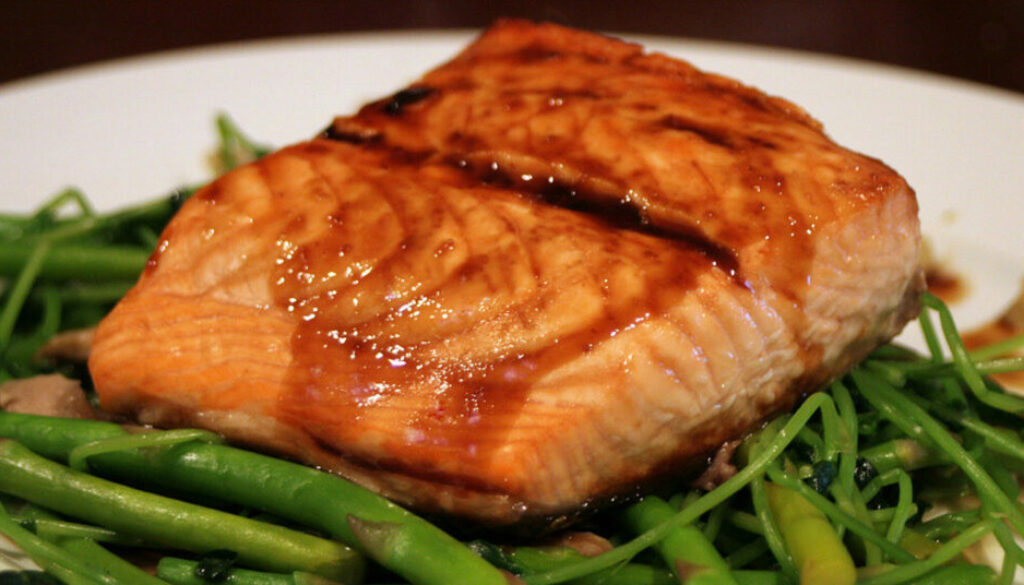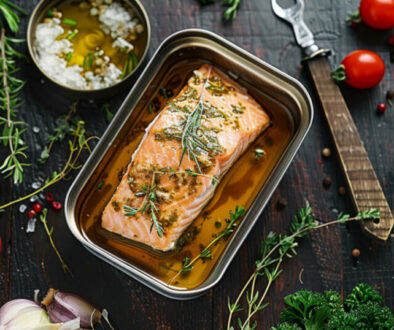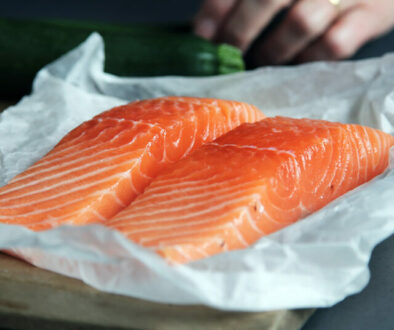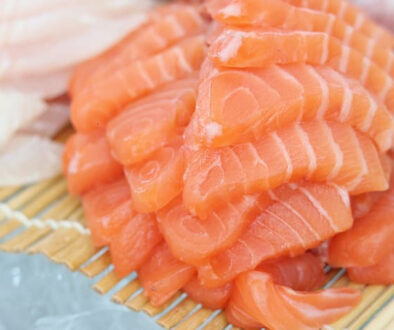Mouthwatering Salmon Sauces: 15 Must-Try Recipes to Elevate Your Next Fish Dish!
Salmon is a delicious and versatile fish that can be cooked in many different ways, from grilling to baking to pan-searing. One way to add extra flavor and complexity to your salmon dish is by pairing it with the perfect sauce. A great sauce can bring out the natural flavors of the fish and elevate it to new heights.
In this blog post, we’ve gathered some classic salmon sauce recipes that will help you take your dish to the next level. Whether you’re looking for a tangy citrus sauce, a rich and buttery sauce, or a spicy and savory sauce, we’ve got you covered.
Each recipe is easy to follow and can be made in your own kitchen with just a few simple ingredients. We’ll also suggest some pairing ideas to help you create a complete dining experience that your guests will love.
So, whether you’re a seasoned home cook or a beginner in the kitchen, this blog post is for you. Explore the flavors, experiment with the recipes, and discover the perfect sauce to complement your salmon dish. You’ll be sure to impress your family and friends with these delicious and easy-to-make salmon sauces.
Sauce Pan Vs Saucier – Which do you need?
Lemon Butter Sauce For Salmon
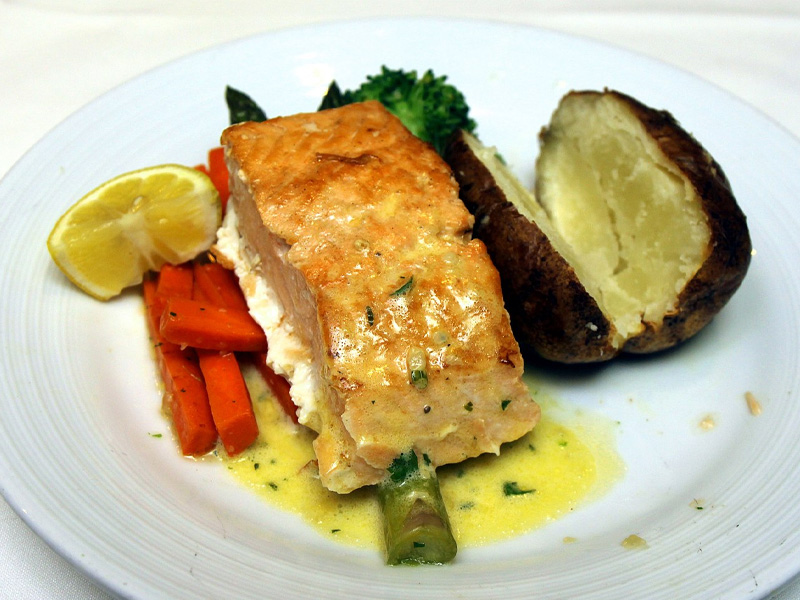
A simple yet elegant sauce, lemon butter sauce combines melted butter, fresh lemon juice, and zest for a tangy and rich flavor that perfectly complements salmon. The citrusy notes of lemon cut through the richness of the fish, creating a well-balanced dish. This versatile sauce works well with various cooking methods, such as grilled, baked, or pan-seared salmon.
Lemon Butter Sauce
Equipment
- 1 Sauce Pan
Ingredients
- 4 tablespoons unsalted butter
- 2 tablespoons fresh lemon juice
- 1 teaspoon finely grated lemon zest
- 1/4 teaspoon salt
- 1/8 teaspoon freshly ground black pepper
Instructions
- Melt the butter in a small saucepan over medium heat, stirring occasionally, until it starts to turn a light golden brown color and smells nutty, about 3-4 minutes.
- Add the lemon juice, lemon zest, salt, and pepper to the pan and stir to combine. Cook for another minute or so, until the mixture is hot and bubbly.
- Remove the pan from the heat and let the sauce cool for a minute or two.
- Spoon the sauce over your cooked salmon and serve immediately. Enjoy!
Notes
Suggested food pairings:
- Vegetables: Steamed or roasted asparagus, green beans, or zucchini provide a crisp, fresh contrast to the rich sauce and tender salmon.
- Starches: Garlic mashed potatoes, herb-roasted baby potatoes, or a lemon and herb couscous add a comforting, hearty element to the dish.
- Grains: A side of quinoa or farro salad with cherry tomatoes and fresh herbs complements the bright flavors of the lemon butter sauce.
- Salads: A simple mixed greens salad with a light vinaigrette, cherry tomatoes, and thinly sliced red onions adds freshness and color to the plate.
- Wines: Pair the dish with a crisp, refreshing white wine such as Sauvignon Blanc, Pinot Grigio, or a dry Riesling to enhance the citrus flavors of the sauce.
With these pairing suggestions, you can create a balanced and delicious meal that showcases the delightful flavors of salmon and lemon butter sauce.
Dill Sauce For Salmon
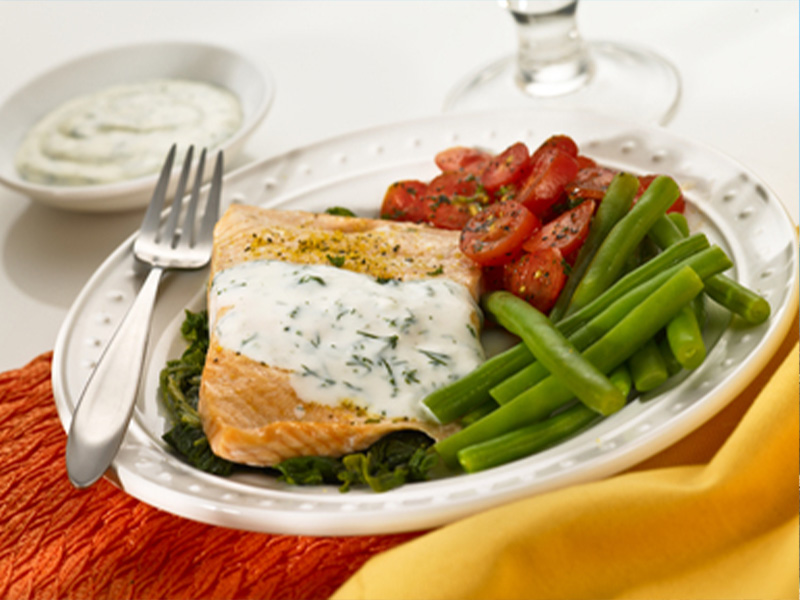
Infused with the fresh and vibrant taste of dill, this light and creamy sauce adds a delightful, herbaceous touch to your salmon dish. Made with a combination of fresh dill, lemon juice, and either yogurt or sour cream, this sauce beautifully enhances the natural flavors of the fish. Ideal for baked, poached, or grilled salmon, dill sauce brings a refreshing, garden-fresh twist to your dining table.
Dill Sauce
Ingredients
- 1/2 cup mayonnaise
- 1/2 cup sour cream
- 2 tablespoons chopped fresh dill
- 1 tablespoon Dijon mustard
- 1 tablespoon freshly squeezed lemon juice
- 1/2 teaspoon garlic powder
- Salt and pepper to taste
Instructions
- In a small bowl, whisk together the mayonnaise, sour cream, dill, Dijon mustard, lemon juice, and garlic powder until well combined.
- Season with salt and pepper to taste, and stir to combine.
- Cover and refrigerate for at least 30 minutes to allow the flavors to meld together.
- Serve the dill sauce alongside your cooked salmon. Enjoy!
Suggested food pairings:
- Vegetables: A medley of roasted root vegetables, such as carrots, parsnips, and beets, adds color, earthy sweetness, and textural contrast to the dish.
- Starches: A side of lemony new potatoes with a touch of olive oil and parsley pairs well with the dill sauce and salmon, offering a warm and comforting element.
- Grains: A tabbouleh salad, made with bulgur wheat, fresh herbs, and a zesty dressing, complements the dill sauce’s bright flavors and adds a Middle Eastern twist.
- Salads: A crisp and tangy Greek salad, featuring tomatoes, cucumber, red onion, Kalamata olives, and feta cheese, adds a Mediterranean flair to the meal.
- Wines: To enhance the refreshing flavors of the dill sauce, opt for a light and zesty white wine such as a Grüner Veltliner, Vermentino, or Albariño.
By incorporating these pairing suggestions, you can create a harmonious and satisfying meal that highlights the irresistible combination of salmon and dill sauce.
Hollandaise Sauce For Salmon
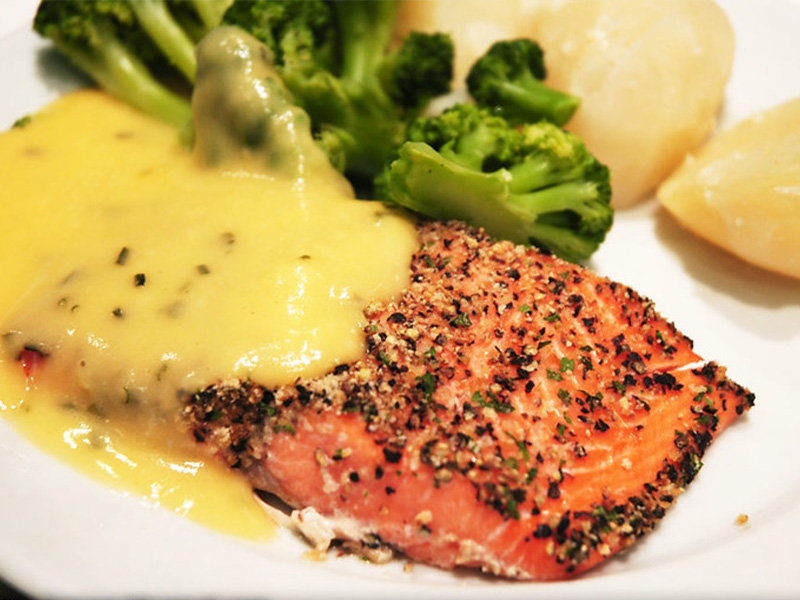
Indulge in the luxurious richness of Hollandaise sauce, a classic French delight that adds a touch of elegance to your salmon dish. This smooth and creamy sauce is made by emulsifying egg yolks, butter, and lemon juice, resulting in a velvety texture that pairs perfectly with baked, poached, or grilled salmon. Ideal for special occasions or a weekend brunch, Hollandaise sauce brings a gourmet experience to your dining table.
Hollandaise Sauce
Ingredients
- 3 egg yolks
- 1 tablespoon freshly squeezed lemon juice
- 1/2 cup 1 stick unsalted butter, melted and clarified
- 1/8 teaspoon cayenne pepper optional
- Salt and freshly ground black pepper to taste
Instructions
- In a heatproof bowl, whisk together the egg yolks and lemon juice until well combined.
- Set the bowl over a saucepan of simmering water (make sure the bottom of the bowl is not touching the water) and whisk constantly until the mixture thickens and becomes light in color, about 2-3 minutes.
- Gradually pour the clarified butter into the egg yolk mixture, whisking constantly, until the sauce is smooth and creamy.
- Stir in the cayenne pepper (if using) and season with salt and pepper to taste.
- Remove the bowl from the heat and serve the sauce immediately, or keep it warm in a heatproof bowl set over a pot of warm water until ready to serve.
Suggested food pairings:
- Vegetables: Blanched or sautéed asparagus, green beans, or broccolini offer a fresh, crisp contrast to the creamy Hollandaise and tender salmon.
- Starches: Herbed potato rosti or crispy hash browns make for a delicious and satisfying side, especially when serving the salmon with Hollandaise for a brunch.
- Grains: A wild rice pilaf, studded with dried cranberries and toasted almonds, brings nutty, earthy flavors and a delightful texture to the plate.
- Salads: A light and delicate butter lettuce salad with a creamy tarragon dressing offers a refreshing and complementary green element to the dish.
- Wines: Pair the dish with a full-bodied and buttery Chardonnay or a bright, fruity Viognier to highlight the sumptuous flavors of the Hollandaise sauce.
By incorporating these carefully selected pairings, you can create an exquisite and memorable meal that showcases the decadent combination of salmon and Hollandaise sauce.
Beurre Blanc For Salmon
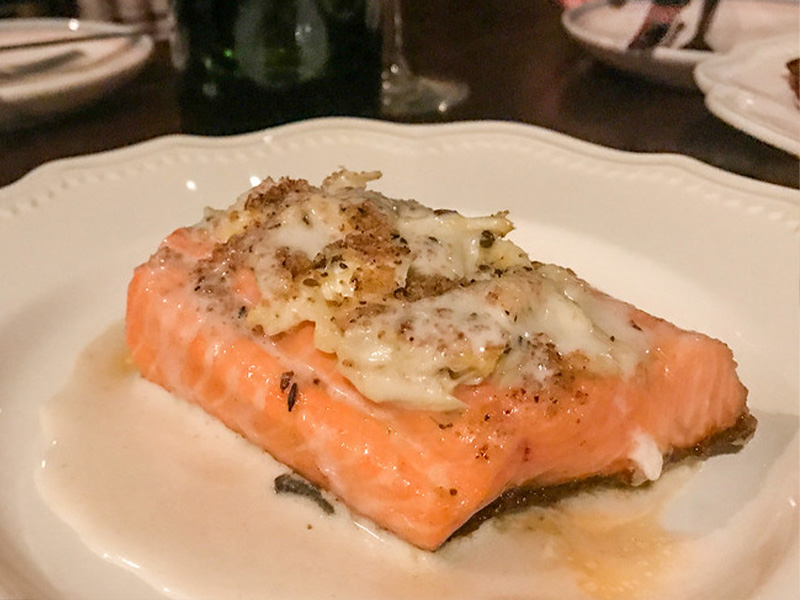
Elevate your salmon dish with the delicate sophistication of Beurre Blanc, a traditional French sauce that adds a touch of culinary refinement to your dining experience. This velvety sauce is crafted by reducing white wine, vinegar, and shallots before gradually whisking in butter to create a smooth, rich texture. Beurre Blanc imparts a subtle, balanced flavor to salmon dishes, making it an excellent choice for baked, poached, or pan-seared fish.
Beurre Blanc Sauce
Ingredients
- 1/2 cup dry white wine
- 1/4 cup white wine vinegar
- 2 tablespoons minced shallots
- 1/2 cup unsalted butter cut into small pieces and kept cold
- Salt and freshly ground black pepper to taste
Instructions
- In a medium saucepan, combine the white wine, white wine vinegar, and minced shallots. Bring to a boil over medium-high heat and cook until the liquid is reduced to about 2 tablespoons, stirring occasionally, for about 10-12 minutes.
- Turn the heat to low, and whisk in the butter a few pieces at a time until the sauce is smooth and emulsified. Keep whisking until all of the butter is melted and incorporated, about 2-3 minutes.
- Remove the pan from the heat and season the sauce with salt and freshly ground black pepper, to taste.
- Strain the sauce through a fine-mesh sieve into a bowl or a warm serving dish. Keep the sauce warm until ready to serve.
Suggested food pairings:
- Vegetables: A side of sautéed or roasted fennel, artichokes, or Brussels sprouts adds a complementary layer of flavor and texture to the dish.
- Starches: Buttery, garlic-infused mashed cauliflower or a creamy celery root purée offers a low-carb alternative to traditional starches, harmonizing with the Beurre Blanc’s smooth texture.
- Grains: A pearl couscous salad with sun-dried tomatoes, Kalamata olives, and fresh herbs brings a Mediterranean touch to the plate, while highlighting the sauce’s complexity.
- Salads: A simple frisée salad with a tangy mustard vinaigrette and thinly sliced radishes adds brightness and crunch, cutting through the richness of the Beurre Blanc.
- Wines: Enhance the sauce’s flavors with a crisp and minerally white wine, such as a Sancerre, Chablis, or a dry Chenin Blanc.
With these inspired pairing suggestions, you can create a refined and satisfying meal that showcases the delightful combination of salmon and Beurre Blanc sauce.
Creamy Mustard Sauce For Salmon
Bold and savory, creamy mustard sauce is a delightful addition to your salmon repertoire. Combining the tangy flavors of whole grain mustard and Dijon mustard with the richness of cream, this sauce adds a flavorful punch to the fish. The robust taste of mustard enhances the natural flavors of salmon, making it a perfect match for grilled, baked, or broiled preparations.
Creamy Mustard Sauce
Ingredients
- 1/2 cup sour cream
- 2 tablespoons dijon mustard
- 1 tablespoon honey
- 1 garlic clove minced
- 1/4 teaspoon salt
- 1/8 teaspoon black pepper
- 1-2 tablespoons milk optional
Instructions
- In a small mixing bowl, whisk together the sour cream, dijon mustard, honey, minced garlic, salt, and black pepper until well combined.
- If the sauce is too thick, you can add 1-2 tablespoons of milk to thin it out to your desired consistency.
- Taste the sauce and adjust the seasoning as needed, adding more salt or pepper to taste.
Notes
Suggested food pairings:
- Vegetables: Tender, buttery sautéed Brussels sprouts or a colorful ratatouille offer a complementary, slightly sweet contrast to the mustard’s sharpness.
- Starches: A side of fluffy herb and cheese polenta or creamy scalloped potatoes provides a comforting, mouthwatering complement to the bold sauce.
- Grains: A warm farro or barley salad with roasted vegetables and a hint of balsamic vinegar adds a nutty, earthy balance to the dish.
- Salads: A fresh arugula salad with goat cheese, toasted walnuts, and a honey-mustard vinaigrette echoes the flavors of the sauce while offering a light, refreshing counterpoint.
- Wines: A medium-bodied white wine with a hint of acidity, such as a Chardonnay, Chenin Blanc, or Verdicchio, pairs well with the creamy mustard sauce and salmon.
With these enticing pairing suggestions, you can create a memorable and delectable meal that showcases the incredible flavors of salmon and creamy mustard sauce.
Pesto Sauce For Salmon
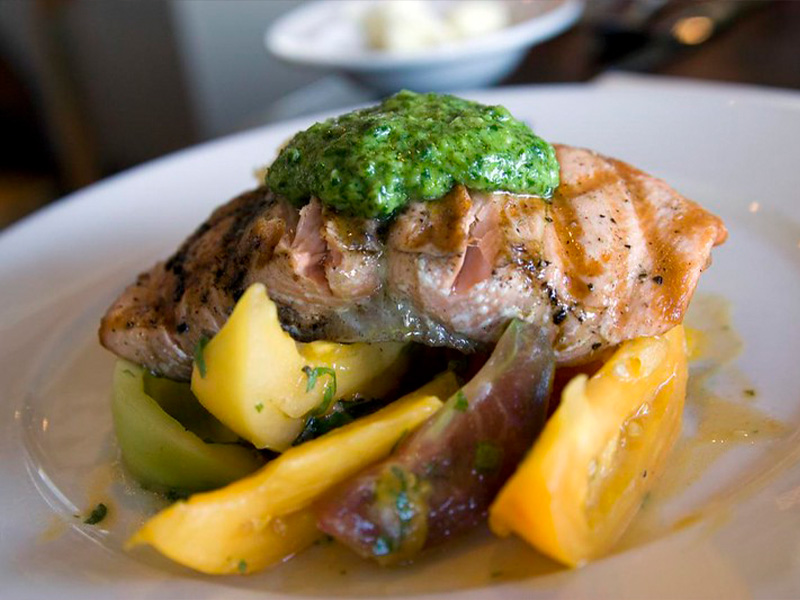
A versatile and aromatic Italian sauce, pesto adds a vibrant touch to your salmon dish. Traditionally made with fresh basil, garlic, pine nuts, Parmesan cheese, and olive oil, pesto brings a burst of bold flavors that pairs beautifully with the richness of the fish. This sauce works exceptionally well with grilled, baked, or pan-seared salmon, offering a fresh and herbaceous Mediterranean twist.
Pesto Sauce
Ingredients
- 2 cups fresh basil leaves packed
- 1/2 cup grated Parmesan cheese
- 1/2 cup extra-virgin olive oil
- 1/3 cup pine nuts
- 3 garlic cloves peeled
- 1/4 teaspoon salt
- 1/4 teaspoon black pepper
Instructions
- Place the basil leaves, Parmesan cheese, pine nuts, garlic, salt, and black pepper in a food processor or blender.
- Pulse the ingredients a few times until roughly chopped.
- With the food processor or blender running, slowly drizzle in the olive oil until the mixture forms a smooth and creamy paste.
- Taste the pesto and adjust the seasoning as needed. If the pesto is too thick, you can add a little bit of water or extra olive oil to thin it out.
- Transfer the pesto to a jar or other airtight container and store in the refrigerator until ready to use.
Suggested food pairings:
- Vegetables: Oven-roasted cherry tomatoes or grilled bell peppers, zucchini, and eggplant offer a colorful and flavorful complement to the pesto-topped salmon.
- Starches: Creamy Parmesan polenta or a side of rosemary and garlic roasted potatoes adds a comforting, rustic element to the dish.
- Grains: A pearl couscous salad with sun-dried tomatoes, olives, and crumbled feta cheese highlights the Mediterranean flavors of the pesto sauce.
- Salads: An arugula salad with a lemon vinaigrette, shaved Parmesan, and toasted pine nuts brings a peppery, crisp freshness to the meal.
- Wines: Pair the salmon with pesto sauce with a lively, herbaceous white wine like Verdicchio, Sauvignon Blanc, or a dry, unoaked Chardonnay to accentuate the fresh flavors.
With these pairing suggestions, you can craft a delectable and well-rounded meal that showcases the irresistible combination of salmon and pesto sauce, perfect for a delightful dining experience.
Teriyaki Glaze For Salmon
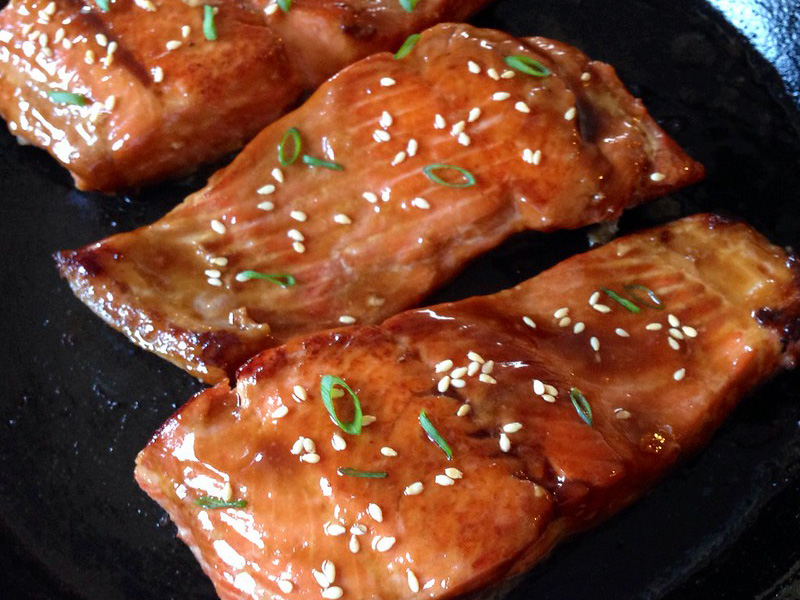
A popular Japanese-inspired glaze, teriyaki sauce brings a delightful balance of sweet, savory, and umami flavors to your salmon dish. Made with a combination of soy sauce, mirin, sugar, and sake or rice vinegar, this sauce creates a caramelized, glossy finish on your grilled, broiled, or baked salmon. The rich, bold flavors of teriyaki sauce add an exciting, Asian-inspired twist to your meal.
Suggested food pairings:
- Vegetables: A side of stir-fried or steamed vegetables, such as bok choy, snow peas, or bell peppers, adds color and a crunchy texture that complements the tender salmon.
- Starches: Steamed jasmine or sticky rice provides a mild, slightly sweet base that absorbs the teriyaki sauce, tying the flavors together in perfect harmony.
- Grains: A noodle dish, such as soba, udon, or rice noodles tossed in a light sesame oil dressing, adds an extra layer of Asian flair to your teriyaki salmon meal.
- Salads: A bright and crunchy Asian slaw made with cabbage, carrots, and a tangy rice vinegar dressing provides a refreshing contrast to the rich teriyaki sauce.
- Wines: A slightly off-dry Riesling or a fruity, aromatic Gewürztraminer can balance the bold flavors of the teriyaki sauce and enhance the overall dining experience.
With these pairing suggestions, you can create a delectable and memorable meal that showcases the enticing fusion of salmon and teriyaki sauce.
Miso Glaze For Salmon
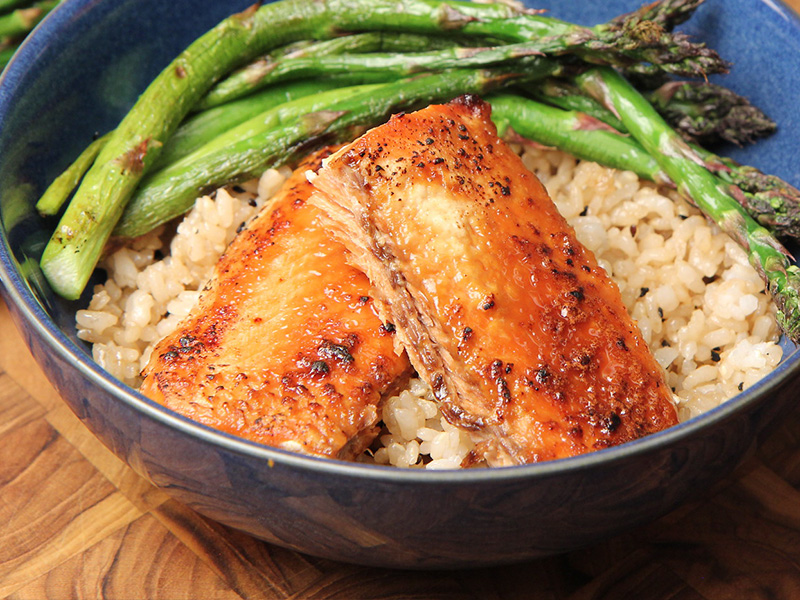
A savory and slightly sweet Asian-inspired glaze, miso glaze brings umami-rich flavors to your salmon dish. Made with a blend of white or red miso paste, mirin, soy sauce, and a touch of sugar, this glaze adds a depth of flavor that complements the natural richness of salmon. Ideal for baked, broiled, or pan-seared salmon, miso glaze creates a caramelized exterior that’s both visually and gastronomically appealing.
Miso Glaze
Ingredients
- 1/4 cup white miso paste
- 1/4 cup honey
- 2 tablespoons rice vinegar
- 1 tablespoon soy sauce
- 2 cloves garlic minced
- 1 teaspoon grated fresh ginger
- 1/4 teaspoon black pepper
Instructions
- In a medium bowl, whisk together the miso paste, honey, rice vinegar, soy sauce, minced garlic, grated ginger, and black pepper until smooth.
Notes
Suggested food pairings:
- Vegetables: Steamed or sautéed bok choy, snap peas, or shiitake mushrooms, lightly seasoned with soy sauce and sesame oil, provide a vibrant accompaniment to the glazed salmon.
- Starches: A side of fluffy jasmine or sticky rice, optionally seasoned with rice vinegar and sesame seeds, serves as a perfect base to soak up the delicious miso glaze.
- Grains: A nutty, chilled soba noodle salad with julienned vegetables and a soy-sesame dressing pairs well with the umami flavors of the miso-glazed salmon.
- Salads: A refreshing Asian-style slaw made with Napa cabbage, carrots, red bell pepper, and a tangy rice vinegar dressing adds a crisp, palate-cleansing component to the meal.
- Wines: To complement the savory-sweet flavors of the miso glaze, choose a fruity and aromatic white wine like Gewürztraminer, Riesling, or an off-dry Chenin Blanc.
With these pairing suggestions, you can create a well-rounded, flavorful meal that showcases the delightful taste of salmon with miso glaze.
Soy-Ginger Sauce For Salmon
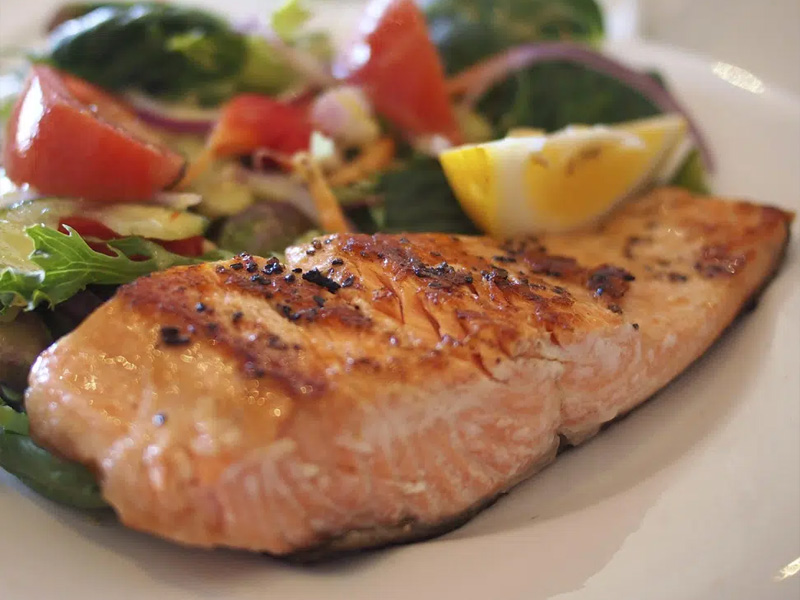
Soy-ginger sauce is a delightful blend of salty, sweet, and slightly spicy flavors, providing a unique Asian-inspired twist to your salmon dish. Combining soy sauce, fresh ginger, garlic, and a touch of sweetness from honey or brown sugar, this sauce creates a beautiful balance of flavors that highlights the rich taste of the salmon. Ideal for marinating, glazing, or simply drizzling over grilled, baked, or pan-seared salmon, soy-ginger sauce offers an exciting alternative to traditional pairings.
Soy-Ginger Sauce
Ingredients
- 1/4 cup soy sauce
- 1/4 cup rice vinegar
- 2 tablespoons honey
- 2 tablespoons minced fresh ginger
- 1 garlic clove minced
- 1 tablespoon toasted sesame oil
- 1 green onion thinly sliced (optional)
- Pinch of red pepper flakes optional
Instructions
- In a small bowl, whisk together the soy sauce, rice vinegar, honey, ginger, garlic, sesame oil, green onion, and red pepper flakes (if using) until well combined.
- Taste the sauce and adjust the seasoning as needed. If it’s too salty, add a bit more honey or rice vinegar. If it’s too sweet, add a bit more soy sauce.
- Let the sauce sit at room temperature for at least 15-20 minutes to allow the flavors to meld together.
- Serve the Soy-Ginger Sauce with your favorite dish, such as grilled chicken, beef, tofu, or vegetables. Enjoy!
How it differs from Teriyaki sauce:
While both soy-ginger and teriyaki sauces share some ingredients such as soy sauce, sugar, and ginger, they differ in their overall taste profiles and cooking applications. Teriyaki sauce typically includes mirin or sake, giving it a slightly sweeter and richer flavor compared to soy-ginger sauce. Additionally, teriyaki sauce is often used as a glaze to create a shiny, caramelized finish on the salmon, whereas soy-ginger sauce can be used as a marinade, dipping sauce, or finishing drizzle.
Suggested food pairings:
- Vegetables: Steamed or sautéed bok choy, snap peas, or broccolini add a fresh, vibrant touch to the dish while complementing the Asian-inspired flavors.
- Starches: Jasmine or basmati rice, flavored with a splash of rice vinegar and a sprinkle of sesame seeds, provides a delicate, fragrant accompaniment to the soy-ginger salmon.
- Grains: A chilled soba noodle salad, tossed with julienned vegetables, cilantro, and a sesame-ginger dressing, adds a refreshing, textural contrast to the dish.
- Salads: A crisp Asian slaw made with thinly sliced cabbage, carrots, bell peppers, and a tangy rice vinegar dressing offers a refreshing, crunchy side that complements the soy-ginger salmon.
- Wines: To balance the savory and slightly sweet flavors of the soy-ginger sauce, opt for a bright, aromatic white wine such as a Gewürztraminer, Viognier, or an off-dry Riesling.
- With these pairing suggestions, you can create a well-rounded and flavorful meal that showcases the delectable combination of salmon and soy-ginger sauce.
Chimichurri Sauce For Salmon
Originating from Argentina, chimichurri sauce brings a burst of bold, herbaceous flavor to your salmon dish. This vibrant green sauce is a blend of fresh parsley, cilantro, garlic, red pepper flakes, red wine vinegar, and olive oil. Its tangy, zesty, and slightly spicy notes add an exciting twist to grilled or pan-seared salmon, creating a fusion of flavors that will delight your taste buds.
Classic Chimichurri Sauce Recipe
Ingredients
- 1 cup fresh parsley leaves packed
- 3 tablespoons fresh oregano leaves packed
- 3 cloves garlic peeled and roughly chopped
- 1/2 teaspoon red pepper flakes optional
- 2 tablespoons red wine vinegar or apple cider vinegar
- 1/2 cup extra-virgin olive oil
- 1/2 teaspoon salt
Instructions
- In a food processor or blender, combine the parsley, oregano, garlic, and red pepper flakes (if using). Pulse until finely chopped.
- Scrape down the sides of the bowl with a spatula, then add the vinegar and salt. Pulse again to combine.
- With the motor running, slowly pour in the olive oil through the feed tube until the sauce is smooth and emulsified.
- Taste and adjust the seasoning, adding more salt or vinegar as needed.
- Transfer the chimichurri sauce to a bowl or jar and let it sit at room temperature for at least 30 minutes to allow the flavors to meld.
- Serve the chimichurri sauce alongside grilled meats, vegetables, or crusty bread. Enjoy!
Suggested food pairings:
- Vegetables: Char-grilled or roasted bell peppers, zucchini, and eggplant provide a smoky, Mediterranean touch that complements the chimichurri sauce and salmon.
- Starches: A side of creamy polenta or a rustic, oven-baked Spanish-style potato dish with onions, tomatoes, and paprika adds warmth and heartiness to the meal.
- Grains: A quinoa salad with black beans, corn, avocado, and a lime-cilantro dressing brings a South American-inspired element to the dish, enhancing the flavors of the chimichurri sauce.
- Salads: A fresh tomato and avocado salad with red onion, lime juice, and a drizzle of olive oil offers a cool, refreshing contrast to the bold, zesty chimichurri sauce.
- Wines: To balance the vibrant flavors of the chimichurri sauce, pair the dish with a crisp, fruity white wine such as a Sauvignon Blanc or a light, aromatic red wine like a Pinot Noir or Gamay.
With these thoughtfully selected pairings, you can create an enticing meal that showcases the delightful marriage of salmon and chimichurri sauce, taking your taste buds on a flavorful journey to South America.
Tarragon Cream Sauce For Salmon
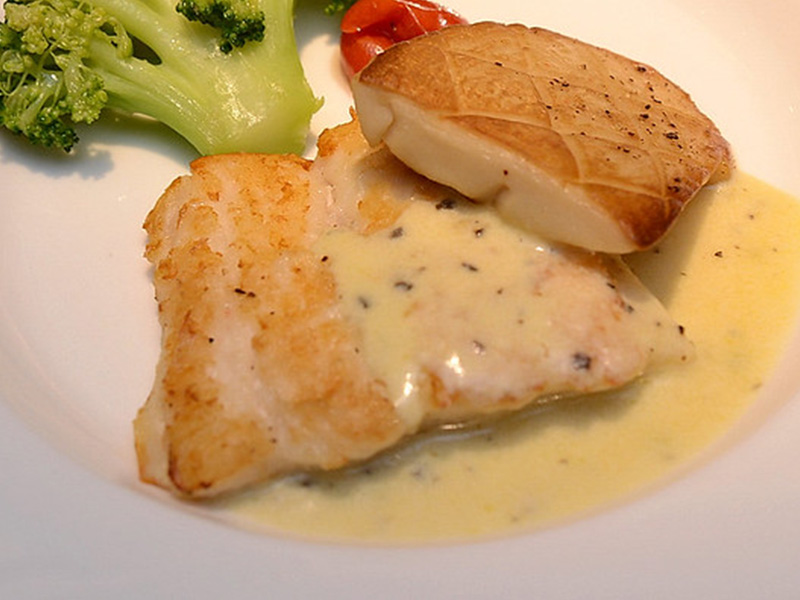
A sophisticated and aromatic addition to your salmon dish, the tarragon cream sauce brings an enticing blend of rich creaminess and fragrant tarragon. Made with fresh tarragon, white wine, shallots, and cream, this sauce adds depth and elegance to your fish. Tarragon cream sauce works exceptionally well with baked, poached, or pan-seared salmon, making it a versatile choice for an unforgettable meal.
Tarragon Cream Sauce
Ingredients
- 2 tablespoons butter
- 1 tablespoon all-purpose flour
- 1/2 cup chicken or vegetable broth
- 1/2 cup heavy cream
- 1 tablespoon chopped fresh tarragon
- 1/4 teaspoon salt
- 1/8 teaspoon black pepper
Instructions
- Melt the butter in a saucepan over medium heat.
- Add the flour and whisk until smooth. Cook for 1-2 minutes, stirring constantly, until the mixture turns light brown.
- Slowly add the broth to the pan, whisking constantly to prevent lumps from forming.
- Add the heavy cream, tarragon, salt, and pepper to the pan and stir to combine.
- Bring the sauce to a simmer and cook for 5-7 minutes, stirring occasionally, until it thickens and coats the back of a spoon.
- Remove the pan from the heat and let the sauce cool for a minute or two.
- Serve the sauce over chicken or fish.
Suggested food pairings:
- Vegetables: A side of haricots verts, quickly blanched and tossed with a touch of butter and a sprinkle of sea salt, provides a bright and delicate accompaniment to the tarragon cream sauce.
- Starches: Creamy, buttery polenta or a fluffy, herb-infused potato puree offers a luxurious and comforting base for the salmon and sauce.
- Grains: A pearl couscous salad with roasted red peppers, sun-dried tomatoes, and fresh herbs complements the flavors of the tarragon cream sauce and adds a Mediterranean touch.
- Salads: A simple yet flavorful arugula salad with shaved Parmesan, toasted pine nuts, and a light lemon vinaigrette adds freshness, texture, and a subtle peppery taste to the meal.
- Wines: To elevate the creamy, herbal notes of the tarragon cream sauce, choose a well-rounded white wine such as a Chardonnay, Viognier, or a White Burgundy.
By incorporating these pairing suggestions, you can create a delightful and memorable meal that showcases the harmonious relationship between salmon and tarragon cream sauce.
Bearnaise Sauce For Salmon
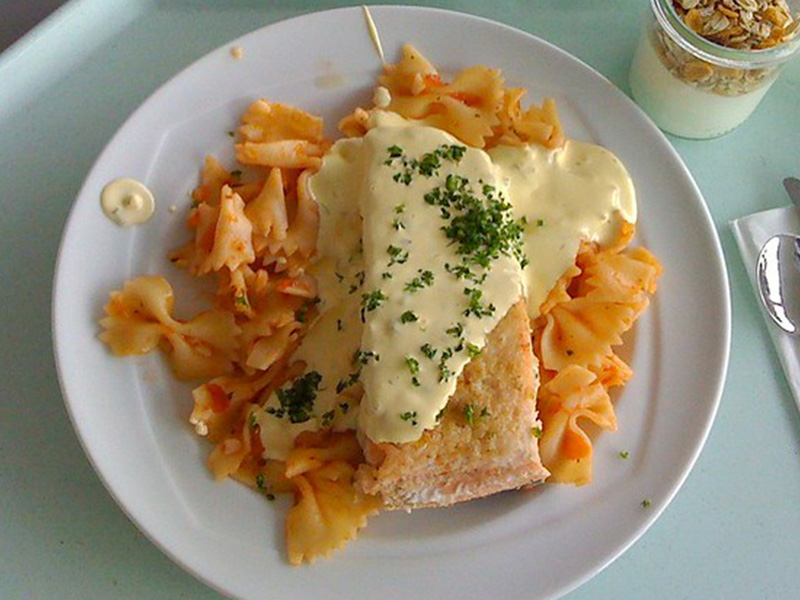
A close cousin to Hollandaise, Bearnaise sauce is a classic French sauce known for its rich, luxurious taste and velvety texture. Made by emulsifying clarified butter, egg yolks, white wine vinegar, shallots, and tarragon, this indulgent sauce elevates your salmon dish to a whole new level. Its complex flavor profile works especially well with grilled, pan-seared, or oven-baked salmon, adding a touch of elegance to any meal.
Classic Bearnaise Sauce Recipe
Ingredients
- 3 egg yolks
- 1/4 cup white wine vinegar
- 1/4 cup dry white wine
- 1/4 cup minced shallots
- 2 tablespoons chopped fresh tarragon
- 1/2 cup unsalted butter melted
- Salt and freshly ground black pepper to taste
Instructions
- In a small saucepan, combine the white wine vinegar, white wine, shallots, and 1 tablespoon of the chopped tarragon. Bring the mixture to a boil over medium heat, then reduce the heat and simmer until the liquid has reduced by half, about 5-7 minutes.
- In a small heatproof bowl, whisk the egg yolks until they are light and frothy.
- Add 1 tablespoon of the reduced liquid from the saucepan to the egg yolks and whisk vigorously to combine. Repeat this process with another tablespoon of the reduced liquid.
- Return the saucepan with the remaining reduced liquid to the stove over low heat. While whisking the egg yolks constantly, slowly pour the egg mixture into the saucepan in a thin stream.
- Continue to whisk the mixture until it thickens and doubles in volume, about 3-5 minutes.
- Remove the saucepan from the heat and slowly pour in the melted butter, whisking constantly until the sauce is smooth and creamy.
- Add the remaining chopped tarragon to the sauce and season with salt and freshly ground black pepper to taste.
- Serve the Bearnaise sauce immediately with steak, grilled fish, or vegetables.
Suggested food pairings:
- Vegetables: Sautéed haricots verts or tender, buttered peas provide a fresh, green contrast to the rich Bearnaise sauce and succulent salmon.
- Starches: For a classic French touch, serve the salmon with a side of creamy, scalloped potatoes or a delicate potato gratin, infused with a hint of garlic and Gruyère cheese.
- Grains: A wild rice pilaf, tossed with toasted almonds, dried cranberries, and fresh herbs, adds an earthy, nutty flavor and pleasing texture to the dish.
- Salads: A simple frisée salad, adorned with crumbled goat cheese, toasted walnuts, and a light champagne vinaigrette, brings a refreshing, crisp element to the meal.
- Wines: To complement the richness of the Bearnaise sauce, pair your salmon with a full-bodied, creamy white wine such as a Chardonnay, Viognier, or White Burgundy.
With these food pairings in mind, you can create a sumptuous, sophisticated meal that showcases the delectable pairing of salmon and Bearnaise sauce, delighting your taste buds with every bite.
Caper Sauce For Salmon
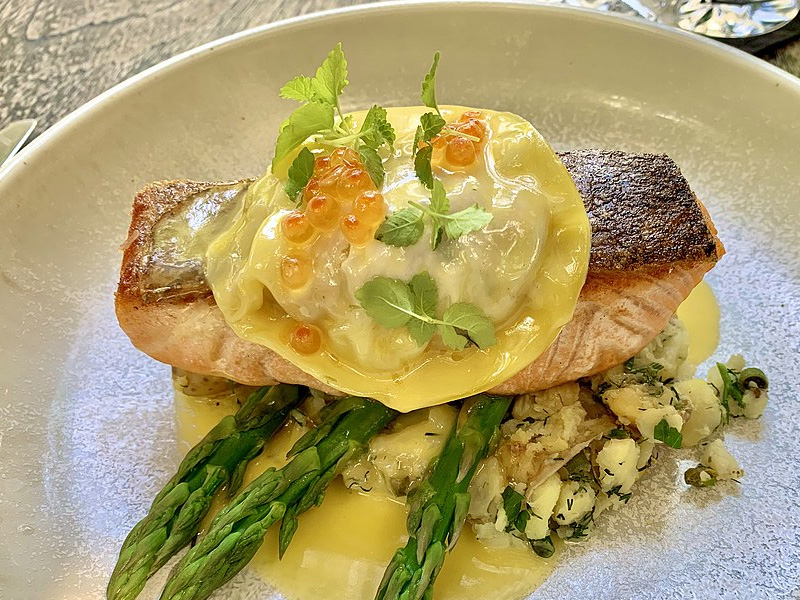
Bursting with briny, tangy flavors, caper sauce adds a delightful contrast to the rich taste of salmon. Made with a blend of capers, lemon juice, white wine or broth, and butter, this sauce brings a touch of Mediterranean charm to your dish. The salty capers balance the natural fattiness of the fish, making it an ideal accompaniment for grilled, baked, or pan-seared salmon.
Caper Sauce Recipe
Ingredients
- 4 tablespoons unsalted butter
- 1/4 cup capers drained and rinsed
- 2 tablespoons freshly squeezed lemon juice
- 2 cloves garlic minced
- 1/4 teaspoon salt
- 1/4 teaspoon freshly ground black pepper
- 1/4 cup chicken or vegetable broth
Instructions
- Melt the butter in a small saucepan over medium heat, stirring occasionally, until it starts to turn a light golden brown color and smells nutty, about 3-4 minutes.
- Add the capers, lemon juice, garlic, salt, and black pepper to the pan and stir to combine. Cook for another minute or so, until the mixture is hot and bubbly.
- Pour in the broth and bring the mixture to a simmer. Cook for another 2-3 minutes, stirring occasionally, until the sauce has thickened slightly.
- Remove the pan from the heat and let the sauce cool for a minute or two.
- Spoon the caper sauce over your cooked fish, chicken, or vegetables and serve immediately. Enjoy!
Suggested food pairings:
- Vegetables: A side of sautéed or roasted fennel with a hint of olive oil and garlic offers a deliciously aromatic and complementary flavor to the caper sauce.
- Starches: Herb-infused orzo pasta, cooked al dente and tossed with a touch of olive oil, adds a delightful, textural contrast to the tender salmon and caper sauce.
- Grains: A warm and nutty farro salad, featuring sun-dried tomatoes, artichoke hearts, and fresh basil, complements the Mediterranean character of the caper sauce.
- Salads: A refreshing arugula salad with thinly sliced red onions, cherry tomatoes, and a lemon vinaigrette brings a light and peppery note to the meal.
- Wines: To accentuate the tangy, salty flavors of the caper sauce, choose a crisp and mineral-driven white wine, such as a Verdicchio, Assyrtiko, or a Chablis.
With these carefully selected pairings, you can create a well-rounded and delicious meal that showcases the delightful pairing of salmon and caper sauce while offering a taste of Mediterranean cuisine.
Horseradish Sauce For Salmon
Add a bold, zesty kick to your salmon dish with a creamy horseradish sauce. This distinctive sauce combines the pungent heat of fresh or prepared horseradish with sour cream or mayonnaise, Dijon mustard, and lemon juice. It cuts through the richness of the fish, creating an exciting flavor profile that awakens the taste buds. Horseradish sauce is especially suited for smoked, grilled, or baked salmon, offering a unique and invigorating twist to your meal.
Homemade Horseradish Sauce Recipe
Ingredients
- 1/2 cup sour cream
- 1/4 cup prepared horseradish
- 1 tablespoon Dijon mustard
- 1 tablespoon lemon juice
- 1/2 teaspoon salt
- 1/4 teaspoon black pepper
Instructions
- In a small bowl, whisk together the sour cream, horseradish, Dijon mustard, lemon juice, salt, and black pepper until well combined.
- Taste the horseradish sauce and adjust the seasoning as needed, adding more salt, pepper, or horseradish to taste.
- Cover the bowl with plastic wrap and refrigerate the horseradish sauce for at least 30 minutes to allow the flavors to meld together.
- When ready to serve, give the horseradish sauce a quick stir and transfer it to a serving dish.
- Enjoy your homemade horseradish sauce as a condiment with your favorite meats or as a dip for vegetables.
Suggested food pairings:
- Vegetables: Tender, buttery sautéed Brussels sprouts or roasted cauliflower offer a nutty, caramelized contrast to the piquant horseradish sauce.
- Starches: A side of creamy, herb-infused scalloped potatoes or a warm, rustic potato salad with grainy mustard provides a comforting, hearty element to the dish.
- Grains: A barley or farro pilaf with toasted nuts, dried cranberries, and fresh herbs adds texture, nuttiness, and a hint of sweetness that complements the bold horseradish sauce.
- Salads: A crisp watercress or arugula salad with thinly sliced radishes, apples, and a light vinaigrette adds a refreshing, peppery crunch to the meal.
- Wines: To balance the spiciness of the horseradish sauce, opt for a fruity, off-dry white wine such as a Gewürztraminer, Chenin Blanc, or a slightly chilled Pinot Noir.
By exploring these pairing suggestions, you can create a dynamic and flavorful meal that showcases the invigorating taste of horseradish sauce with salmon. Delight your guests and enjoy a memorable dining experience with this unexpected, yet delectable combination.
Maple Glaze For Salmon
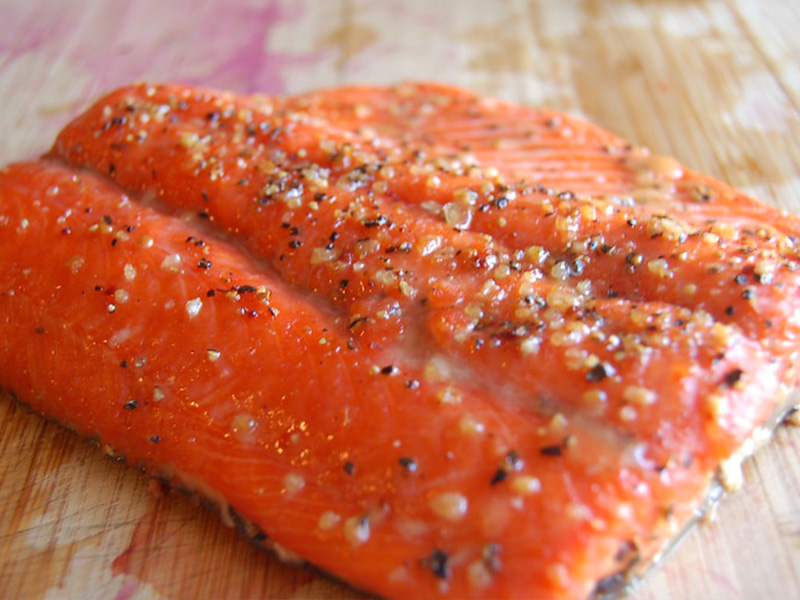
Sweet and savory with a touch of warmth, maple glaze adds a delightful depth of flavor to your salmon dish. Made with a blend of pure maple syrup, Dijon mustard, soy sauce, and a hint of garlic, this glaze brings a delicious, caramelized finish to your fish. Perfect for oven-baked or grilled salmon, maple-glazed salmon is a crowd-pleaser that offers a unique twist on traditional seafood preparations.
Maple Glaze Recipe
Ingredients
- 1/2 cup maple syrup
- 2 tablespoons brown sugar
- 1 tablespoon soy sauce
- 1 tablespoon Dijon mustard
- 1 tablespoon apple cider vinegar
- 1/2 teaspoon garlic powder
- 1/2 teaspoon onion powder
- Salt and pepper to taste
Instructions
- In a small saucepan, combine the maple syrup, brown sugar, soy sauce, Dijon mustard, apple cider vinegar, garlic powder, and onion powder. Stir to combine.
- Heat the mixture over medium heat, stirring occasionally, until the brown sugar has dissolved and the mixture has thickened slightly, about 5-7 minutes.
- Remove the saucepan from the heat and let the glaze cool for a minute or two.
- Taste the glaze and adjust the seasoning as needed with salt and pepper.
- Brush the glaze onto your cooked meats or vegetables, or drizzle it over your desserts, and serve immediately.
Suggested food pairings:
- Vegetables: Roasted Brussels sprouts, butternut squash, or sweet potatoes provide a balance of flavors, complementing the sweetness of the maple glaze while adding a touch of earthiness to the dish.
- Starches: A side of wild rice pilaf, studded with dried cranberries and toasted pecans, adds a nutty, chewy texture and harmonizes with the maple glaze’s sweet undertones.
- Grains: A warm barley salad with roasted root vegetables, toasted almonds, and a light vinaigrette offers a hearty and comforting accompaniment to the maple-glazed salmon.
- Salads: A fresh and tangy apple slaw, featuring thinly sliced apples, shredded cabbage, and a light, creamy dressing, adds a crisp contrast to the rich, sweet glaze.
- Wines: Pair the dish with a fruit-forward and slightly off-dry white wine, such as a Chenin Blanc, Gewürztraminer, or Viognier, to accentuate the maple glaze’s sweetness and balance the flavors.
With these thoughtfully selected pairings, you can create a well-rounded and memorable meal that showcases the irresistible combination of salmon and maple glaze.
Enhance Your Salmon Game with Classic Sauces
In conclusion, exploring the world of classic salmon sauces can add new dimensions to your favorite seafood dishes. From the bright and tangy lemon butter sauce to the sweet and savory maple glaze, these versatile sauces elevate your salmon, whether you’re serving it at a casual dinner or a special occasion. By incorporating the suggested food pairings, you can create well-rounded, harmonious meals that showcase the delightful flavors of these sauces and satisfy the taste buds of all your guests.
Now it’s time to get creative in the kitchen and discover the perfect sauce for your next salmon dish. With these 15 classic salmon sauces at your fingertips, you’ll have a delicious culinary adventure awaiting you each time you cook. Happy cooking!
Cover photo credit: “Salmon with Soy Honey and Wasabi Sauces” by Maggie Hoffman is licensed under CC BY 2.0 .
